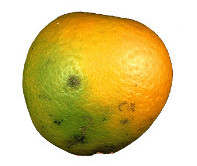
Citrus greening, also called huanglongbing (HLB) was being experienced in China in the early 1900’s and perhaps even prior to that in India, is spread by a bacterium carried by the Asian citrus psyllid. Since its first appearance in the Americas in Brazil in 2004, it took only a year to crop up in Florida. By 2009, the disease had spread so badly that growers were warned that citrus production would be a dead industry within 5 years, and indeed by 2019 HLB was estimated to have affected 90% of the citrus tree population.
Apart from implementing more vigilant inspection of tree health, combined with increased pesticide use to try to kill the psyllids, together with hygienic removal of affected trees, there was initially nothing more that could be done.
The first breakthrough was accidental, when researchers who were working to produce a new variety discovered that their new hybrid, released in 2009 as “Sugar Belle” was able to tolerate HLB, so that while the plant still became infected it remained an excellent producer of quality fruit.
What is greening tolerance?
The problem with HLB is that it decimates the tree’s phloem. Citrus tolerant
Greening tolerant plants look healthy and produce quality fruit and juiceplants grow a larger amount of new phloem after infection compared to non-tolerant trees, maintaining the tree’s ability to transport nourishment to leaves, flowers, and fruit.
What might be the future of citrus growing?
Currently the goal is to continue to improve greening tolerance and some scientists have focussed on research around phloem production, but the aim is to arrive at the “holy grail” of actual resistance to greening.

Researchers at the University of Florida are experimenting with gene editing (CRISPR) to alter the “susceptibility genes” so that the tree can actually protect itself from the pathogen and not be capable of becoming infected. Although years away, there is significant optimism for this strategy, as lead researcher Nian Wang has already achieved this step for citrus canker.
Other scientists are studying whether they can use another pathogen, such as citrus tristeza virus, as a “messenger” to deliver HLB-killing proteins, or other molecules poinsonous to psyllids but harmless for the tree, in order to successfully treat trees and eradicate HLB. One such molecule currently being studied is a class of peptide called defensin and which is derived from spinach.
Still other scients are looking at using natural defences such as fungi, or using genetic engineering to better control or eliminate the psyllids themselves in a very species-specific way.
At Citrific Nursery we remain committed to providing the best citrus products which research makes safe and possible, as soon as possible in order to benefit our growers.
